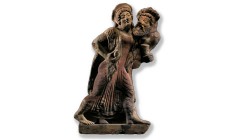Understanding the international market in illicit cultural objects
The quantitative part of the overall research programme, headed up by Neil Brodie and called ‘measuring the international market in illicit cultural objects’, involves statistical work to answer questions about the size and shape of this particular illicit market. By contrast, and complementarily, my project is about ‘understanding’ rather than ‘measuring’, and involves qualitative interviews with key market participants.
There are qualitative strands to some of the other projects in the research programme too. For example, Donna Yates has a research plan which includes ethnographic observation and interview research in Latin America, creating a picture of the local contexts of trafficking, and comparing antiquities trafficking to the significantly better researched drug traffic in the region. Jessica Dietzler is comparing the successes and failures of different regulatory regimes across a number of transnational criminal markets, and part of her research will involve interviews with law enforcement actors (police, customs agents, etc) in source, transit and market countries in order to better understand the key practical problems they experience in trying to control illicit trade, and the policing strategies which are thought by law enforcement actors to be the most effective.
To support these qualitative research efforts, my contribution will involve depth interviews with important actors in the market – broadly including high-level dealers, significant collectors, large auction houses and major museums. Much of the recent criminological writing on the global antiquities trade has attempted to provide a more sophisticated view of the boundary between licit and illicit than a simple bifurcation between a legitimate trade and an illegitimate or underground trade. In common with many other types of illicit market, it has begun to be recognised that the market in cultural objects is a ‘grey’ market, in the sense that illicit artefacts enter the legal chain of supply and become difficult to identify as having unlawful origins (Polk 2000; Bowman 2008; Mackenzie 2011). This raises a host of questions about the role of the public antiquities trade in providing on the one hand a source of demand for illicit antiquities which has been argued to drive the looting problem at source (Coggins 1969; Elia 1994), or alternatively a protective barrier against the insertion of illicit antiquities into the open trade where dealers or others are able to identify them as such.
What are the best ways to encourage and support this type of anti-crime response from dealers? What is the role of shady, untrustworthy, or criminal dealers in the ordinary functioning of the market? What does the market consider appropriate, sensitive, but effective regulation to look like? Does criminalisation work as a deterrent in this field? These are some of the questions this research will seek to answer, through trade interviews in some of the main centres of global dealing in cultural objects such as London, Hong Kong, and New York.
References
Bowman, B.A. (2008) ‘Transnational Crimes Against Culture: Looting at Archaeological Sites and the ‘Grey’ Market in Antiquities’, Journal of Contemporary Criminal Justice, 24(3): 225-42.
Coggins, C. (1969) ‘Illicit Traffic of Pre-Columbian Antiquities’, Art Journal, Fall: 94-8.
Elia, R.J. (1994) ‘The World Cannot Afford Many More Collectors with a Passion for Antiquities’, The Art Newspaper, 41(October): 19.
Mackenzie, S. (2011) ‘The Market as Criminal and Criminals in the Market: Reducing Opportunities for Organised Crime in the International Antiquities Market’, in S. Manacorda and D. Chappell (eds) Crime in the Art and Antiquities World: Illegal Trafficking in Cultural Property. New York: Springer.
Polk, K. (2000) ‘The Antiquities Trade Viewed as a Criminal Market’, Hong Kong Lawyer, September: 82-92.
